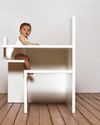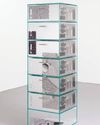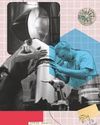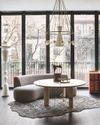On the eve of the Museum of Modern Art’s landmark exhibition on the past, present, and future of fashion, Metropolis VP of design Paul Makovsky spoke to MoMA’s senior curator Paola Antonelli about why she chose to put on a show about garments, why Bernard Rudofsky (who curated MoMA’s first show on fashion back in 1944) remains as relevant as ever, and the challenges of selecting fashion objects that have had a strong impact on the world.

Paul Makovsky: Why and how did you come up with the idea for Items: Is Fashion Modern?
Paola Antonelli: I’ve been at MoMA for 23 years now, and I came on board having studied architecture, and having worked in fashion—I was an intern working for Armani’s PR office in Milan. So I was always thinking about fashion.
At MoMA, I started to sort of assess the landscape—I saw the Geoffrey Beene exhibition at FIT that blew me away—and I asked Philip Johnson, who had interviewed me for my job, “What about fashion?” And he gave me the official explanation: Fashion is so ephemeral, it’s so dictated by seasons, it really goes against the idea of timelessness that is at the core of the idea of Modern.
I just didn’t buy it because he had done the Deconstructivist Architecture show, and there was nothing more ephemeral, more trend-based than that show. I kept mulling it over, then slowly I would inject little pieces of fashion in the collection, but always based on other excuses, like with the Humble Masterpieces exhibition—we added the white T-shirt—or another time we added the Final Home parka.
PM: How did you organize your research for the exhibition?
PA: I kept this list called “garments that changed the world.” I was convinced that you cannot tell a real, MoMA-style history of Modern design and architecture without garments. So fashion is the system and clothes are the pieces inside. I kept this list, and at some point, I was talking about it with the chief curators and MoMA’s director, Glenn Lowry, and he said, “Have you thought of doing the fashion show?” And I said, “Let me try.”
PM: How many items did you finally end up with?
この記事は Metropolis Magazine の October 2017 版に掲載されています。
7 日間の Magzter GOLD 無料トライアルを開始して、何千もの厳選されたプレミアム ストーリー、9,000 以上の雑誌や新聞にアクセスしてください。
すでに購読者です ? サインイン
この記事は Metropolis Magazine の October 2017 版に掲載されています。
7 日間の Magzter GOLD 無料トライアルを開始して、何千もの厳選されたプレミアム ストーリー、9,000 以上の雑誌や新聞にアクセスしてください。
すでに購読者です? サインイン

No New Buildings
The energy already embodied in the built environment is a precious unnatural resource. It’s time to start treating it like one.

The Circular Office
Major manufacturers are exploring every avenue to close the loop on workplace furniture.

Signs of Life
Designers, curators, and entrepreneurs are scrambling to make sense of motherhood in a culture that’s often hostile to it.

Interspecies Ethic
In probing the relationship between humans and nature, two major exhibitions question the very foundations of design practice.

Building on Brand
The Bauhaus turned 100 this year, and a crop of museum buildings sprang up for the celebration.

Building for Tomorrow, Today
Radical change in the building industry is desperately needed. And it cannot happen without the building trades.

Strength from Within
Maggie’s Centres, the service-focused cancer support network, eschews clinical design to arm patients in their fight for life.

Next-Level Living
The availability of attractive, hospitality-grade products on the market means everyday consumers can live the high life at home.

Mi Casa, Su Casa
Casa Perfect creates a memorable shopping experience in lavish private homes.

Enter The Culinarium
AvroKO imagines the future of residential amenities—where convenience, comfort, and sustainability meet.